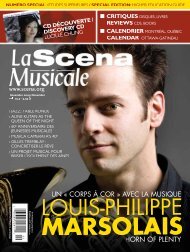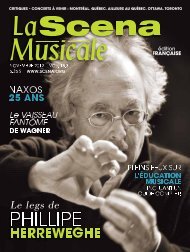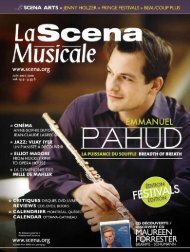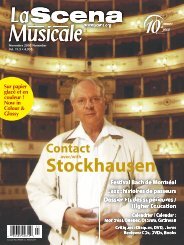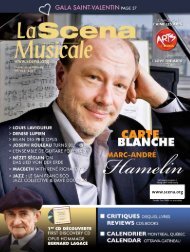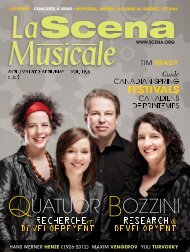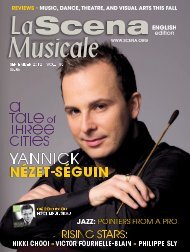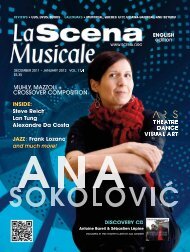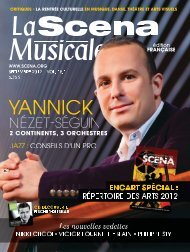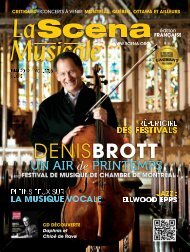You also want an ePaper? Increase the reach of your titles
YUMPU automatically turns print PDFs into web optimized ePapers that Google loves.
THE CLASSICAL<br />
MUSIC AND JAZZ<br />
QUARTERLY<br />
MAGAZINE<br />
FOR SOUTHERN<br />
ONTARIO AND<br />
WESTERN<br />
CANADA<br />
Subscription 1 year $20<br />
*Free for subscribers of <strong>La</strong> <strong>Scena</strong> <strong>Musicale</strong><br />
Fall 2005 Interview with Cecelia Bartoli<br />
Now on sale at newsstands in Eastern Canada $4.95<br />
WWW.SCENA.ORG<br />
Daniel Taylor and<br />
the Theatre of Early Music<br />
exclusively with BIS<br />
Available in Canada<br />
October/November 2005:<br />
LOVE BADE ME WELCOME<br />
Renaissance duets and<br />
songs with countertenors<br />
James Bowman and<br />
Daniel Taylor<br />
featuring poetry read by actor Ralph Fiennes<br />
“James Bowman in magical form with Daniel Taylor,<br />
Canada’s hottest countertenor...” (Toronto Star)<br />
Upcoming events for Daniel Taylor include Gabrieli Consort (Recording For<br />
DGArchiv), L'Ensemble Orchestrale De Paris (Recording For<br />
EMI), Canadian Opera Company Bach Collegium Japan<br />
(Recording For BIS), and his Debuts with Munich Opera,<br />
Deutsche Philharmonie and the Amsterdam Baroque<br />
Orchestra<br />
Also available on BIS<br />
“a beauty and purity that bows to no other” (Gramophone)<br />
McGill Suite de la page 19<br />
vement plus lyrique dans l’escalier qui rampe à l’intérieur et fait<br />
une vrille dans la bibliothèque. Comme une ligne mélodique se<br />
promène entre les temps d’une mesure, on peut y voir une envolée<br />
lyrique dans un système plus linéaire. »<br />
Après avoir réalisé plusieurs projets dans le milieu universitaire,<br />
on comprend que Gilles Saucier traite les étudiants comme une<br />
clientèle à part. « Il y a une efficacité et une durabilité qu’il faut<br />
avoir quand on construit pour une école. Il faut que l’édifice résiste<br />
au temps et à une usure prématurée. On sent tout de suite la<br />
réaction des étudiants si ça ne convient pas : le contrôle ne s’installe<br />
pas et l’harmonie se perd. Les bunkers sans fenêtres étaient<br />
une erreur, je pense qu’il y a moyen de construire une architecture<br />
qui est efficace, intéressante et stimulante pour les étudiants. »<br />
Architecture et musique<br />
Avec un tel site et un tel programme, l’agence<br />
Saucier+Perrotte a choisi de créer un édifice comme moyen de<br />
communiquer. Il aurait peut-être été plus idyllique de le retrouver<br />
dans les arbres et la montagne, mais le projet urbain déploie son<br />
génie lorsqu’on y entre, passant des éclatants bruits de la ville à un<br />
calme inespéré. <strong>La</strong> musique au centre de l’activité humaine. « Il y a<br />
toutes sortes de gestes dans l’art d’aller écouter de la musique,<br />
dont celui d’être là », affirme Gilles Saucier. « Garnier en a parlé<br />
avant nous avec son grand escalier à l’Opéra de Paris lorsqu’il disait<br />
‘voir et être vu’. Aller au théâtre pour l’événement que cela représente.<br />
Si l’architecture n’avait pas besoin d’exister, on resterait tous<br />
à la maison avec nos baladeurs, on n’aurait pas besoin d’espace<br />
public pour se voir, se rencontrer. L’architecture est au service de<br />
l’expérience musicale et crée un sens de la communauté. » Le nouvel<br />
édifice de la faculté de musique de McGill répond à ce profond<br />
désir de rassemblement. Tous ceux qui doutaient encore de l’importance<br />
d’investir dans notre culture observent maintenant le<br />
silence. p laurajotte@yahoo.fr<br />
« J'ai le droit d'exister comme architecte contemporain,<br />
j'ai l'obligation d'exister et j'ai l'obligation du respect<br />
de ma société. Faire une chose en faux-vieux, ce n'est<br />
pas respecter les gens pour qui je travaille et la cause<br />
que je défends. »<br />
– Gilles Saucier<br />
McGill continued from page 19<br />
building for a school,” he says. “The infrastructure has to stand up to<br />
a great deal of wear-and-tear for a long period of time. And you can<br />
tell right away if the students react badly to a space – there’s no regular<br />
pattern or harmony. All those windowless bunkers from the ’70s<br />
were a mistake, really. There’s a way to build architecture that is efficient<br />
but also interesting and stimulating for students.”<br />
Architecture and Community<br />
Given such a marvellous site and an ambitious cultural mandate,<br />
Saucier & Perrotte chose to design a building whose function and<br />
theme would be community. A more idyllic project might have included<br />
leafy surroundings on the slopes of Mount Royal, but the urban<br />
genius of the layout is immediately clear once you emerge (escape?)<br />
from the bustling clamour of the street into this oasis of calm where<br />
music is celebrated as the greatest focus of human activity. “The role<br />
of the audience is just as crucial to that celebration,” Saucier believes.<br />
“Look at the great staircase Garnier designed for the Paris Opera: it<br />
allows the spectators to be seen, and to see each other. It helps turn<br />
an event into a community. If architecture didn’t have this role to play,<br />
we would just listen to music at home – with our iPods – and forget<br />
about encountering each other in a public space through art.” As any<br />
visitors will certainly attest, the new centre of McGill’s Faculty of Music<br />
meets this profound need for musical communion in resoundingly<br />
accomplished style. p<br />
[Translation: Tim Brierley]<br />
22 octobre 2005 october





